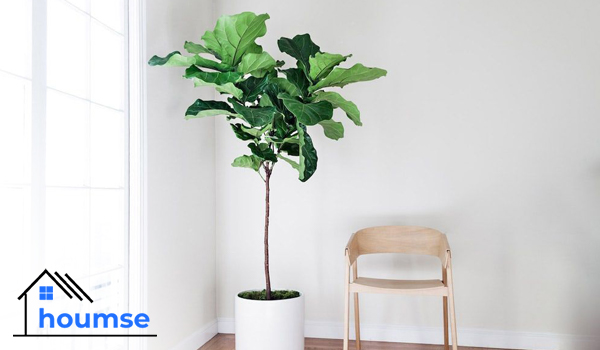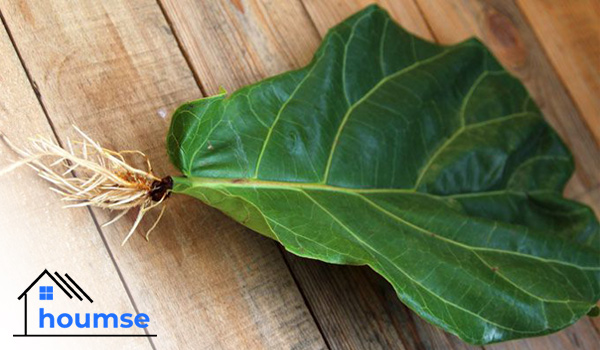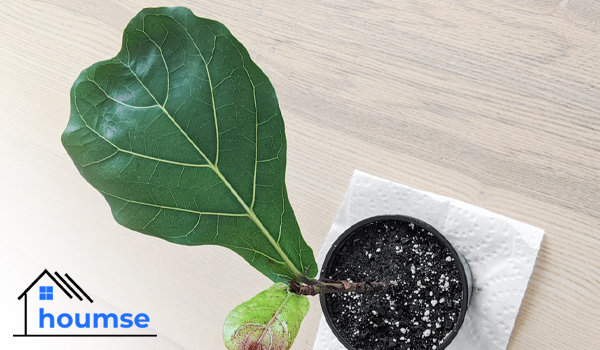Fiddle Leaf Fig Tree Indoor Care (Full Guide)

Would you like to grow a fig tree indoor? Well, that may not be the best idea. While growing fig plant indoor, meaning Ficus carica or the edible fig, you cannot provide one of its most vital requirements properly; and that is light as the fig tree plant needs full sun in the summer.
Although the fig tree goes into dormancy for the winter and does not need sunlight at all during this period, it loses its leaves in fall and becomes huge, gangly, and messy. Now, if you are still set about growing a fig tree indoor, we have a better suggestion: the fiddle leaf fig tree also known as Ficus lyrata.
This is a fig tree variety that you can proudly grow indoors. Scroll through to find out everything you need to know about how to care for fiddle leaf fig.
Fiddle Leaf Fig Tree Info
Also called banjo fig, this gorgeous plant features very large, heavily veined, and glossy leaves that are shaped like a violin. These signature leaves grow upright on the plant’s sleek trunk and create a statement-making focal point.
Indoors, the fiddle leaf fig tree can grow up to 10 feet in height. While outdoors, it can grow as tall as 50 feet. As a houseplant, it is best to grow it in a floor-standing container where the fig tree plant can grow to at least 6 feet tall.
This broadleaf evergreen is native to tropical western Africa, where it thrives in part shade and loamy, moist soil. It flowers as well, but you should not really expect them while growing a fiddle leaf fig tree indoor.
Is Fiddle Leaf Fig Tree Pet Friendly?
As an excellent alternative to fig plant indoor, a drawback for this species may be its toxicity to cats and dogs.

How to Care for Fiddle Leaf Fig
In their natural habitat, these species thrive in warm and wet conditions. A condition that may be challenging to simulate for fig tree indoor care. However, the odds are evened out thanks to the hardy nature of these trees.
Reading the requirements below, you will realize that banjo fig (especially compared to the charm that it offers to your room) is not actually demanding at all.
Light
For a successful fig tree indoor care, you need to provide it with bright, filtered light. Beware of the direct sunlight like the hot afternoon sun as it can burn its beautiful leaves. Insufficient light can lead to a slow growth rate too.
To help the plant grow evenly and not lean toward the light, make sure to rotate it every few days so all of the parts receive enough sun exposure.
It is also recommended to dust the leaves with a damp cloth every couple of weeks in fiddle leaf fig plant indoor care. This makes the leaves more vibrant and shiny, but more importantly, it allows the leaves to receive more sunlight for better/more photosynthesis.
Watering Fiddle Leaf Fig Tree
Banjo fig enjoys moderately moist soil and anything less than that results in wilting or pale leaves on your lovely houseplant. Watering the fiddle leaf fig tree too much also creates problems such as dropping leaves and root rot that may eventually kill the plant.
To prevent these scenarios, water the plant when the top inch of soil feels dry during the growing season (spring to fall). And during cold months, water slightly less.
Tip: As the Ficus lyrata is sensitive to high salt levels in the soil, to prevent salt build-up, flush the soil every month until water comes out from the drainage holes.
Soil and Plant Food
The ideal soil for fiddle leaf fig tree indoor is the one that is loamy and well-draining with medium moisture and a 6 to7 PH. However, you can safely and soundly plant and grow it in any quality indoor plant potting mix, as long as it has proper drainage.
Apply a high-nitrogen fertilizer during the growing season. Use the label instructions, after all this is a tree and not a delicate houseplant! You can also use the plant foods that are specially made for banjo figs.
Temperature
Extreme temperature changes are not welcomed in fiddle leaf fig care. So keep the plant away from drafty areas, as well as air-conditioning and heating vents to prevent such sudden temperature shifts.
Your plant will be fine in such a spot in rooms with between 60 and 85 degrees Fahrenheit temperatures.

Humidity
A humidity level between 30 and 65 percent is perfect for the fiddle leaf fig tree indoor care. If you need to supplement humidity, use a humidifier or mist the plant with clean water every day.
You can place it on a tray of pebbles filled with water. Just make sure that the bottom of the pot does not touch the water.
Fiddle Leaf Fig Tree Pruning
Having a trimming schedule while caring for the fiddle leaf plant indoor can benefit it greatly. Remove any damaged or dead leaves by pulling them gently (before trying to cut them) as well as overgrowth or crossing branches to boost the plant’s health. To encourage a bushier growth habit, you may cut back the top of the main stem.
Tip: To avoid any damage while pruning, make the cuts about an inch away from the trunk.
Potting and Re-potting
Since this is a relatively fast grower (2 feet a year), it is good to know how to transplant it in addition to how to care for fiddle leaf fig. If you have a young species, you need to re-pot it each spring.
In order to do so, prepare a sturdy container that is about 2 inches larger in diameter than the old pot. Then, gently loosen the fig tree plant, lift it out while supporting its base, place it in the new pot, and fill the empty spaces with a suitable potting mix.
If you have a really large, mature Ficus lyrata, since it is difficult to re-pot, simply remove the first few inches of soil annually in spring and add fresh soil.
If the plant’s size is not a problem, you can re-pot your fiddle leaf fig tree outdoors too. Just make sure that the temperature is above 50 degrees Fahrenheit to prevent stressing the plant.

Common Pests and Problems in Fiddle Leaf Fig Care
As a fairly tough plant, it does not have a serious pest or disease issues. However, due to poor condition and fiddle leaf fig tree indoor care, it can be susceptible to spider mites, scale, and bacterial or fungal diseases.
Noticing spots or dark patches on the foliage as well as small bugs on the leaves are evident signs of such disease. Once you spot these signs, treat your banjo fig using an appropriate fungicide, pesticide, or home remedies. To prevent future issues, provide adequate air circulation after treating.
Apart from the common pest, changes in the environment and watering schedule in fiddle leaf fig tree indoor care can result in other damages. This damage shows itself through leaves pretty clearly so you can root the source of the plant’s distress:
- Light Brown or Bleached Spots: If you see such patches, it means that your Ficus lyrata is receiving too much direct sunlight and now is sunburnt or scorched. Remove the leaf with sharp shears and place the fig tree indoor away from harsh sunlight.
- Brown Spots or Edges: If extreme temperature shifts are not the reason, dark brown spots or browning edges on the leaves indicate root rot. To make sure, check if the roots are brown and mushy. If this is the case, gently remove both spotted leaves and mushy parts of the roots. Plant the fig tree plant in a new pot and monitor the irrigation.
- Yellowing: New yellow leaves are bad new in fiddle leaf fig tree indoor care as they are a sign of a bacterial problem. Cut the affected leaves away and re-pot the plant in fresh soil immediately. But keep in mind that it may be too late to save your plant.
- Dropping: In general, leaves on this species drop due to too much or insufficient water. Extreme temperature changes can make the leaves drop too. Relocate your banjo fig away from all heating or draft sources and decrease watering. As mentioned above, the soil should be slightly moist and not soggy.

Fiddle Leaf Fig Tree Propagation
Now that you know how to care for fiddle leaf fig, let us see how you can propagate it. The best method is using stem cuttings. Unlike sowing seeds, this method never fails you. Follow the instructions below to propagate the fiddle leaf fig tree:
- Prepare a container that can keep the cutting upright and fill it with clean, chlorine-free water. Use distilled water or let tap water sit overnight.
- Choose a stem with two or three healthy leaves (A cutting with more leaves require too much energy to grow), cut about 3 inches below the first leaf using a sharp tool.
- Dip the stem in a rooting hormone and immediately place it in water. Such products promote strong growth and photosynthesis as well as protect the cuttings against probable diseases.
- Place the fiddle leaf fig tree indoor in a bright location without direct sunlight. Check its water and light every few days. If the water looks dirty, replace it with clean, chlorine-free water at room temperature.
- Roughly a month later you will notice the root system developing at the bottom of the plant. After a month, you are ready to plant the young fig plant indoor in moist potting soil. Keep the soil evenly moist for the next two months to help the roots establish well.
After three months, you can treat it as a mature plant and even fertilize it regularly. However, it still requires attention and patience up to the first year.
Final Thoughts
Growing a fig tree indoor is almost impossible. Although they may be a more exciting choice compared to the snake plant, pothos, etc. the challenges are undeniable. And at the end of the day, they are still large trees that cannot thrive as they are intended in closed spaces.
Hopefully, this article about how to care for fiddle leaf fig helps you experience something really close to growing a fig tree plant indoors.
What is your opinion? Do you still find the idea of growing a fig plant indoor more intriguing? Should we have another post about fig tree indoor care? Let us know!
- In this post:
- Fiddle Leaf Fig Tree Info
- How to Care for Fiddle Leaf Fig
- Common Pests and Problems in Fiddle Leaf Fig Care
- Fiddle Leaf Fig Tree Propagation



